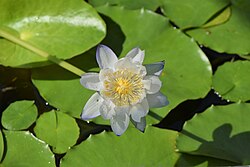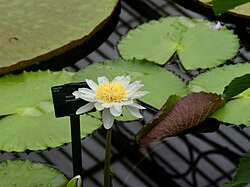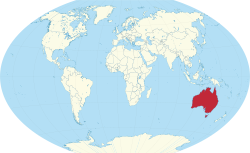Biology:Nymphaea immutabilis
| Nymphaea immutabilis | |
|---|---|

| |
| Flowering Nymphaea immutabilis in cultivation at the Berlin Botanical Garden and Botanical Museum | |

| |
| Flowering Nymphaea immutabilis in cultivation at the Royal Botanic Gardens, Kew | |
Script error: No such module "Conservation status".
| |
| Scientific classification | |
| Kingdom: | Plantae |
| Clade: | Tracheophytes |
| Clade: | Angiosperms |
| Order: | Nymphaeales |
| Family: | Nymphaeaceae |
| Genus: | Nymphaea |
| Species: | N. immutabilis
|
| Binomial name | |
| Nymphaea immutabilis S.W.L.Jacobs[1]
| |

| |
| Nymphaea immutabilis is native to Western Australia, the Northern Territory, and Queensland, Australia[1] | |
| Synonyms[1] | |
| |
Nymphaea immutabilis is a species of waterlily native to Western Australia, the Northern Territory, and Queensland, Australia.[1]
Description
Vegetative characteristics
Nymphaea immutabilis is an annual or perennial plant with globose rhizomes.[2] The round, 70 cm wide leaves have dentate margins.[3][2]
Generative characteristics
The flowers extend up to 50 cm above the water surface.[3] The flowers have four sepals, and 34 petals. The androecium consists of 400 stamens. The gynoecium consists of 9-20 carpels.[2] The globose, 5 cm wide fruit bears numerous 4 mm long, and 2.5 mm wide, rounded seeds with trichomes arranged in irregular rows.[3] Immature seeds are red, but mature to brownish-grey seeds.[4] The seeds have a mechanism of physiological dormancy.[5]
Cytology
The chromosome count is n = 42. The genome size is 1408.32 Mb.[6]
Reproduction
Generative reproduction
Flowering occurs from March to November.[3][2]
Taxonomy
Publication
It was first described by Surrey Wilfrid Laurance Jacobs in 1992.[1]
Type specimen
The type specimen was collected by S. Jacobs and J. Clarkson near Mareeba, Queensland, Australia on the 26th of July 1987.[2]
Placement within Nymphaea
It is placed in Nymphaea subgenus Anecphya.[5]
Separation of Nymphaea kimberleyensis
The subspecies Nymphaea immutabilis subsp. kimberleyensis S.W.L.Jacobs was described in 1992. Later in 2011, it was elevated to a separate species Nymphaea kimberleyensis (S.W.L.Jacobs) S.W.L.Jacobs & Hellq.[7][8]
Etymology
The specific epithet immutabilis, meaning unchanging, references the floral colouration, which does not change as the flower ages.[2]
Conservation
The NCA status of Nymphaea immutabilis is Special Least Concern (SL).[9] In the Northern Territory it is categorised as vulnerable.[10][11]
Ecology
Habitat
It occurs in swamps,[5] permanent, or temporary waters,[2] billabongs, streams, and rivers.[4]
References
- ↑ 1.0 1.1 1.2 1.3 1.4 "Nymphaea immutabilis S.W.L.Jacobs" (in en). Royal Botanic Gardens, Kew. http://www.plantsoftheworldonline.org/taxon/960894-1. Retrieved 2 January 2024.
- ↑ 2.0 2.1 2.2 2.3 2.4 2.5 2.6 Jacobs, S. W. L. (1992). "New species, lectotypes and synonyms of Australasian Nymphaea (Nymphaeaceae)." Telopea, 4(4), 635-641.
- ↑ 3.0 3.1 3.2 3.3 Stephens, K. M., Dowling, R. M. (2002). "Wetland Plants of Queensland: A Field Guide." p. 56. Kokosinsel (Keeling): CSIRO Publishing.
- ↑ 4.0 4.1 Dalziell, E. L. (2016). "Seed biology and ex situ storage behaviour of Australian Nymphaea (water lilies): implications for conservation (Doctoral dissertation, PhD thesis. University of Western Australia, Perth, WA)."
- ↑ 5.0 5.1 5.2 Dalziell, E. L., Baskin, C. C., Baskin, J. M., Young, R. E., Dixon, K. W., & Merritt, D. J. (2019). "Morphophysiological dormancy in the basal angiosperm order Nymphaeales." Annals of botany, 123(1), 95-106.
- ↑ Chen, F., Liu, X., Yu, C., Chen, Y., Tang, H., & Zhang, L. (2017). "Water lilies as emerging models for Darwin’s abominable mystery." Horticulture research, 4.
- ↑ Jacobs, S. W., & Hellquist, C. B. (2011). "New species, possible hybrids and intergrades in Australian Nymphaea (Nymphaeaceae) with a key to all species." Telopea, 13(1-2), 233-243.
- ↑ "Nymphaea kimberleyensis (S.W.L.Jacobs) S.W.L.Jacobs & Hellq." (in en). Royal Botanic Gardens, Kew. http://www.plantsoftheworldonline.org/taxon/77111424-1. Retrieved 2 January 2024.
- ↑ Cite error: Invalid
<ref>tag; no text was provided for refs namedQueensland Government, 2022 - ↑ White, M., Albrecht, D., Duguid, A., Latz, P., & Hamilton, M. (2000). "Plant species and sites of botanical significance in the southern bioregions of the Northern Territory. Volume 1: significant vascular plants."
- ↑ Fisher, A., Baker, B., & Woinarski, J. (2002). "Mitchell Grass Downs, Northern Territory."
Wikidata ☰ Q17253189 entry
 |

